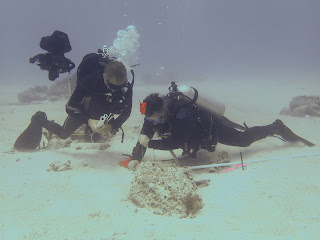Sitrep
Every morning this week, I have eagerly opened my email and scanned the messages for one word: "Sitrep." It's a short-hand for "situation report" that is typically used in military operations. And it's what I'm living for right now.
 |
| Calvin and Evan collecting samples in Saipan. Photo by Jen McKinnon. |
This project is different from anything I've ever done before, and it's my first time working with the DPAA (Defense POW/MIA Accounting Agency). My lab was approached initially because we are one of the few research labs across the country that integrate biology and archaeology and have extensive experience working in the ocean. We're also collaborating with the University of Wisconsin Biotechnology Center and East Carolina University.
It's different for me to be geographically separated from the field operation, but I still feel very involved. On more than one occasion, my phone has chimed in the middle of the night with a question. At one point, Calvin hand-drew a sampling scheme that was slightly modified from my original idealized scenario and sent it to me for approval. Another time, I texted asking for an update at what must have been an obnoxious hour in Saipan. The 15-hour time change is a challenge, but we're staying connected.
 |
| Calvin and Evan deploying flags to mark sampling locations at a site in Saipan. Photo by Jeremy Borrelli. |
You may not know this, but I actually struggle sometimes with my role as a scientist. I question whether what I do is valuable or whether it contributes anything positive to the world. When it comes to the eDNA project, though, I do not question the value at all. If our methods work, it could result in more efficient means to localize, identify, and recover human remains from the wreckage of past wars. I'm proud to contribute, even in a small way, to bringing service members home.
Comments
Post a Comment